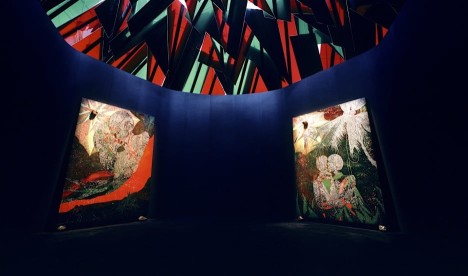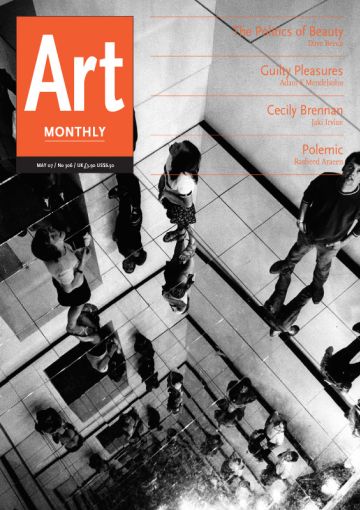Polemic
Inverted Racism?
Rasheed Araeen delivers a polemic on the cultural policies of positive discrimination

installation view of Chris Ofili’s British Pavilion presentation at the 2003 Venice Biennale
I wonder if anyone noticed the racial exclusivity of the decibel awards (AM302) for ‘UK-based artists of Asian, black African, or black Caribbean decent’. Imagine an organisation which openly announces and offers awards only to white artists. Would there not be an outcry for this racism? But why is the art community silent about Arts Council England’s (ACE) inverted racism?
ACE defends its policy in giving these exclusive awards on the basis of the Race Relations Act of 1976, which allows government bodies to provide support and funds exclusively to those community groups which are racially discriminated against. But are artists of ‘Asian, black African, or black Caribbean descent’ (hereafter ‘black’) being discriminated against? Where and what is the evidence for this?
In 1992, I had a dispute with an Arts Council officer regarding an INIVA conference at the Tate Gallery in 1994. Sir Christopher Frayling (now ACE’s chair) called a meeting to resolve this dispute. During the meeting I said something (I have now forgotten what) which infuriated two of the Visual Arts Committee members. They in fact began shouting, saying that I was making fuss about nothing. Their point was that there was no problem regarding black artists as they were now showing everywhere, which indeed raised an important question: if even 15 years ago there was no problem facing black artists, why was ACE then setting up INIVA, and why has it since spent almost £50m in establishing several ethnically based separate art organisations?
In some respects, the Visual Arts Committee members were right. The early 1990s was the time when black artists did begin to show, following Anish Kapoor’s award at the Venice Biennale in 1990, and then his winning of the Turner Prize the following year. What has since happened can only be described as phenomenal. In the last 15 years, three black artists have won the Turner Prize besides others also being nominated for it while another, Chris Ofili, represented Britain at the 2003 Venice Biennale. Some have received residencies and other awards, in addition to their unprecedented success in the marketplace both nationally and internationally. If we enumerate this success in proportion to the Afro-Asian population of Britain, it surpasses the success of white artists.
If the facts of the last 15 years tell us a story of phenomenal black success, what is the basis of the view that black artists are actually and still being discriminated against, and how? If ‘institutional racism’ is the basis of discrimination, as ACE’s recent publication Respond seems to suggest, how does it occur or manifest itself and what are its consequences? Can ACE be explicit and tell us what exactly it means by ‘institutional racism’ in relation to art and how it has been disadvantaging black artists?
ACE has in fact quoted the Commission for Racial Equality in its report, which says: ‘Institutional racism is that which, covertly or overtly, resides in the policies, procedures, operations and culture of public or private institutions – reinforcing individual prejudices and being reinforced by them.’ It also quotes The Macpherson Report, which says that it is not just a simple discrimination but a ‘discrimination through unwitting prejudices, ignorance, thoughtlessness and racist stereotyping which disadvantage minority ethnic groups’.
The Macpherson Report came out in 1999, following the murder of Stephen Lawrence, but the question of institutional racism concerning art had already been raised in the early 1970s in both artworks and art writings – to which the art establishment paid no attention. It wasn’t then the result of someone’s murder, although racial murders did take place, but there was clear evidence that artists of both Asian and African origins were indeed being denied their place in the mainstream. It was not because they had not been producing something worthwhile, but their perception as ‘other’ precluded them from mainstream British culture. If we look at the period particularly between the mid 1960s and mid 1980s – a period of almost 20 years – we see that none of these artists was visible within the art system. Even those artists who were highly successful in the late 1950s and early 1960s disappeared from official exhibitions and publications, and indeed from the debate and discussion about art to which they had contributed. I have referred to this period because of its historical importance: it was then that black artists penetrated the central core of Modernism, confronted it and redefined it beyond its Eurocentricity and laid a foundation for a true cultural diversity within an integrated British mainstream. Why is this important development within postwar Modernism not recognised and integrated into mainstream art history? Why has ACE paid little attention to this black exclusion from British culture? If ACE is really concerned with institutional racism, shouldn’t it be looking for its roots historically and deep within the institutionalised discourse? In other words, the problem here is of a historical nature.
I am not, however, suggesting that what happened in the past should necessarily be considered more significant than the work of the present generation of black artists. But can we understand the present without knowledge of the past? Indeed, can we understand the situation today without understanding what has actually been the nature of art produced historically following the postwar immigration from Asia, Africa and the Caribbean, and why its diversity has been ignored or suppressed? What I am here evoking is an extremely difficult and complex question, and I know it cannot be resolved easily. It cannot even be grasped, let alone resolved, by the kind of multicultural rhetoric we hear from ACE. This is partly due to a confusion between racism and discrimination, because racism does not always or necessarily produce what is commonly understood by the term discrimination. On the contrary, it can create fascination for the other and produce paternalistic benevolence in the beholder possessing power, leading to the kind of attitudes and policy that produce cultural separatism and inverted racism.
What we face today, as a result of ACE’s politically misguided and culturally flawed policies, is an extremely dangerous situation. At a time when society must demolish all those barriers which prevent cultural integration and establish a common framework to which all its citizens – irrespective of their racial or cultural origins – can aspire and contribute, ACE is engaged in fragmenting and dividing society. This is not an issue about who is included and who is excluded from the system, but what kind of society we want to create in Britain. Should it be divided into separate ethnic communities or integrated into a multicultural whole? The answer to this must not be left to an individual like myself but to the whole art community. When is the art community as a whole going to stand up and face this issue?
Rasheed Araeen is founding editor of Third Text.
First published in Art Monthly 306: May 2007.









